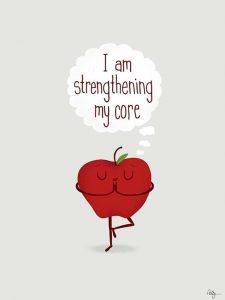Osteopathy, core strength & low level core exercises

Background
Low back pain (LBP) can be the result of a number of different things, including but not limited to overuse, muscle strain, ligament sprain and injury to the intervertebral discs that support the lumbar spine. Dysfunction that is not managed correctly may, in time, lead to an overall imbalance and chronic muscle tension.
Rehabilitation programmes and/or preventative programmes for LBP sufferers should focus on strengthening both the deep abdominal muscles and the lumbar spine muscles. This, combined with core stability and proprioception, will reduce the risk of LBP as long as the exercises are performed both correctly and regularly.
It is important to seek a proper diagnosis from your osteopath or another medical professional before beginning any strenuous rehabilitation exercises. It is advisable to be guided towards the most appropriate exercise protocol for your own specific circumstances.
Core blimey!
The core is comprised of several groups of muscles, including the transversus abdominus, multifidus, diaphragm and pelvic floor muscles. Working together to produce maximum stability in the abdominal and lumbar spine region, these muscles also co-ordinate the movement of the arms, legs and lumbar spine. Engaging these muscles is not something that most people do consciously. Therefore it is important to learn how to effectively co-contract these muscles whilst carrying out these rehabilitation exercises.
How do I engage my core?
Place two fingertips on the bony prominences on the front of your hips (the anterior-superior iliac spine or ASIS). Move your hands in an inch towards your belly button and then another inch down towards your toes. You should now be directly over the transversus abdominus muscle. When the core is correctly contracted, you should feel a gentle tightening under your fingertips. If the muscles under your fingers start to protrude, then you are contracting too much and compensating with larger muscle groups. It is important to learn how to engage your core in various positions (sitting, standing, lying down) as well as during activity in order to provide maximum stability for your spine.
Core strength & stability
The aim of a programme of core strength and stability exercises is twofold; firstly to aid recovery after an injury and secondly as a preventative measure. A programme would ideally incorporate a combination of flexibility and strengthening work. Flexibility should be carried out at least 5 times a week and the strengthening section should be done 3-4 times a week.
Typically the exercises are classified into 3 levels: ‘easy’, ‘moderate’ and ‘difficult’. It is recommended that you start with the ‘easy’ exercises and only move onto the ‘moderate’ and ‘difficult’ ones once these have been perfected. It is important to understand the function of the muscles you are working as well as how the exercises should feel in order to know if you are performing the exercises correctly.
Flexibility
A lack of flexibility through the hips (hamstrings, hip flexors & gluteal / buttock muscles) can contribute to LBP by increasing the workload of the lumbar spine. As such it is important to focus on improving your flexibility if you are experiencing LBP. All stretches should be ‘LBP-free’ and a sign that you have prematurely progressed onto a more challenging level would be aggravation of your LBP during or immediately after stretching.
Quadriceps stretch
- Stand on your left leg, supporting yourself as required by holding onto something solid such as a wall or chair.
- Bend your right knee and bring your right heel towards your buttock.
- Reach for your ankle with your right hand and hold onto the dorsal surface (the shoelace part of a shoe) of your right foot.
- Stand up straight, relax your shoulders and pull in your abdominal muscles, trying to keep your knees next to each other. You will feel a slight pull along the front of your right thigh and hip.
- Keep breathing and hold the stretch for 20-30 seconds, release and repeat on the left leg, this time holding your ankle with your left hand.
- Perform 3 repetitions on each side.
Avoid bouncing, locking out the standing knee (keep it soft) or allowing the bent knee to drift outwards. The goal is not to touch your heel to the buttock, but rather to feel the gradual stretch in the front of the thigh.
Deep hip flexor stretch
- Begin in a forward lunge position with your right leg forward, dropping your left knee to the ground.
- Place your right elbow on the inside of your right knee.
- Press your right elbow gently into your right knee and twist your torso to the left.
- Reach your left arm behind you until you feel a gentle stretch in your lower back and right groin.
- Keep breathing and hold the stretch for 20-30 seconds, release and repeat on the left leg.
- Perform 3 repetitions on each side.
This stretch should be done after you have warmed up your muscles (e.g. brisk walking) rather than stretching cold muscles. Be sure to keep your forward knee over or behind your ankle. Avoid letting your knee extend in front of your ankle as this stresses the knee. Again, do not bounce or force the stretch, merely apply mild pressure to enhance it.
Adductor stretch
- Stand with your legs wide apart.
- Shift your weight to the left.
- Allow your left knee to bend until it is over your left foot, allowing you to feel the stretch in your right groin.
- Keep your feet on the ground facing forward.
- Keep breathing and hold the stretch for 20-30 seconds, release and repeat on the opposite leg.
- Perform 3 repetitions on each side.
Hamstring stretch
- Stand up straight with your right heel resting on a small stack of books or a low stool.
- Keep this knee straight.
- Reach both arms up into the air so that your arms are about even with your ears, your back is straight and you are bending forward slightly from the hips.
- Reach forward and feel a stretch in your hamstrings at the back of the right thigh.
- Keep breathing and hold the stretch for 20-30 seconds, release and repeat on the left leg.
- Perform 3 repetitions on each side.
Gluteal stretch
- Lie flat on your back with both knees bent. Cross the right leg over the left leg, so your right foot is resting on the left knee.
- Bring both knees towards your chest and gently pull the left leg (the un-crossed leg) towards you until you feel a stretch in your right buttock.
- Keep breathing and hold the stretch for 20-30 seconds, release and repeat on the left leg.
- Perform 3 repetitions on each side.
Core Exercise Examples
There are plenty of core exercises from which to choose. Here are a few examples for each level of progression.
Dead Bug (Easy Level)
- Lie on your back with your arms extended toward the ceiling and your legs in a tabletop position (knees bent at 90 degrees and stacked over your hips). This is start position.
- Slowly extend your right leg out straight, while simultaneously dropping your left arm overhead. Keep both a few inches from the ground. Squeeze your buttock muscles and keep your core engaged the entire time, lower back pressed into the floor.
- Bring your arm and leg back to the starting position.
- Repeat on the other side, extending your left leg and your right arm.
- Continue alternating sides for 20 repetitions on each side.
Tabletop Leg Press (Easy Level)
- Lie on your back with your legs raised in a tabletop position (knees bent 90 degrees and stacked over your hips).
- Contract your deep abdominal muscles to press your low back into ground.
- Crunch up just a few inches and place your hands on the front of your quadricep muscles on the front of each thigh.
- Drive your quadriceps into your hands while simultaneously pressing them away. There should be no visible movement in your body, but you should feel the tension in your core.
Panther Shoulder Tap (Moderate Level)
- Start on all fours.
- Engage your core and while keeping your back flat and your bottom down, lift your knees off the floor about 1-3 inches. Gaze at the floor a few inches in front of your hands to keep your neck in a comfortable position.
- Tap your right hand to your left shoulder and then your left hand to your right shoulder, while using your core strength to keep your hips as still as you can.
- Continue alternating sides for 20 repetitions on each side.
Half Kneeling Wood Chop (Moderate Level)
- Start on your knees, and then step the left leg a few feet in front of the right leg, left foot flat on the floor and left knee bent at 90 degrees.
- Hold a light-to-medium dumbbell beside the left knee. Grasp onto both ends of the weight. This is start position.
- Bring the weight diagonally up toward the ceiling on the opposite (right) side of your body, twisting your abdominal muscles as you do. Keep both hips facing forward—only your core muscles should be rotating.
- Bring the weight back down to the start position.
- Do 20 your reps on the left side, and then repeat on the right side.
Side Bend (Difficult Level)
- Start in a side plank with your right hand on the floor, directly underneath your right shoulder, and your feet staggered so that the left is right in front of the right.
- Stack your left foot on top of your right foot.
- Engage your core and contract your buttock muscles.
- Let your left arm relax by your left side.
- Dip your hips down toward the ground and then lift them back up (this is 1 repetition).
- Do 10 repetitions on your right side and then repeat on the left side.
This is only the start! If you would like to discuss any aspect of your LBP management, please do not hesitate to contact us: 01525 290 615. We would be delighted to hear from you.


